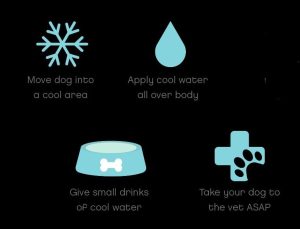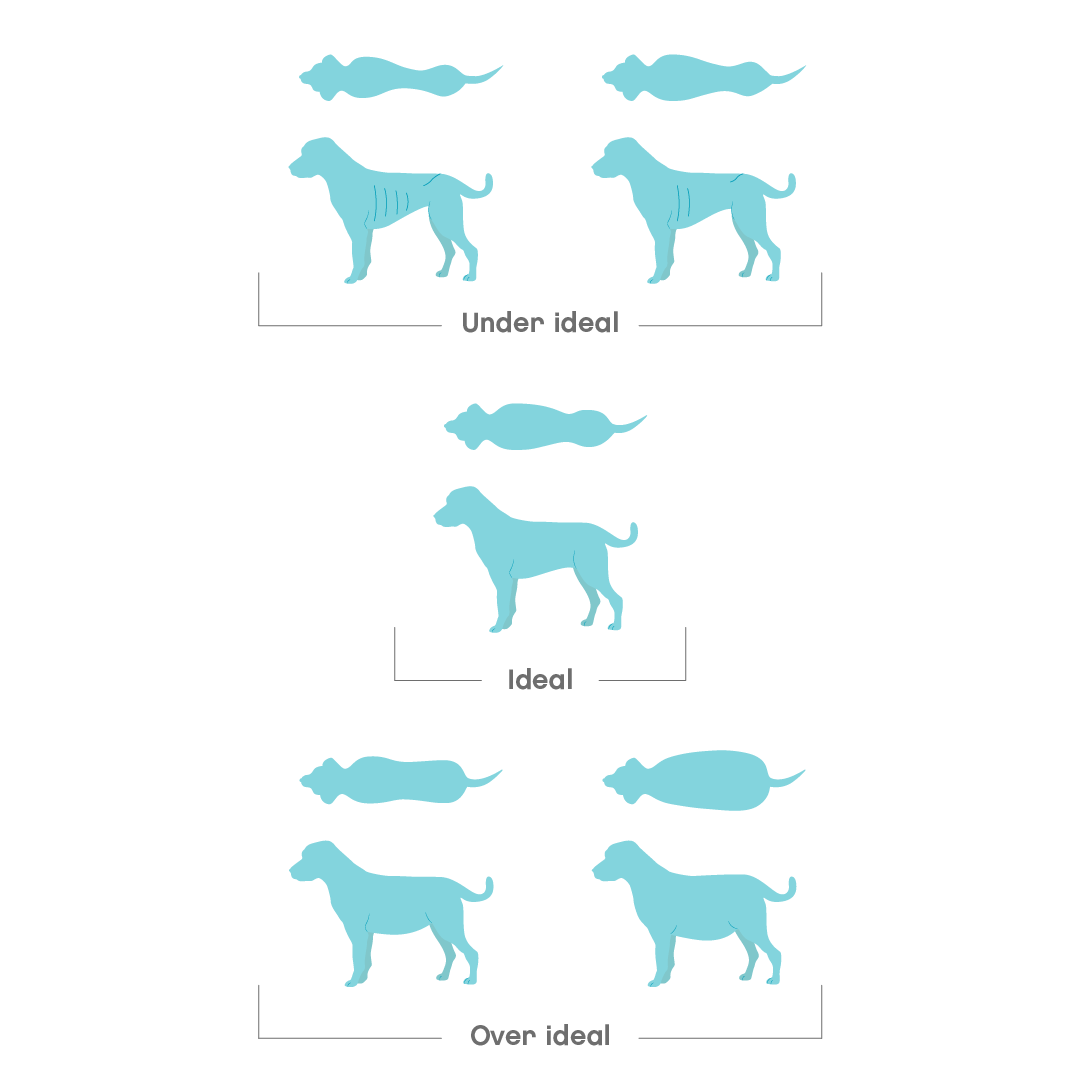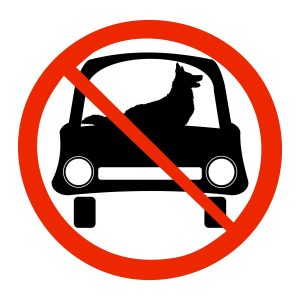Heat stroke is a very dangerous condition. It requires immediate attention, or it can be fatal. Remove your dog from the heat or sun if symptoms develop and contact your local vet.
The most common cause of heat stroke in dogs is overheating during play or exercise. It can also be due to sitting in the sun or heat for too long. This can be inside a vehicle or building as well as outdoors.
Home treatment
What to do if your dog has heat stroke
If your dog starts showing signs of heat stroke at home, act calmly but quickly. The quicker the treatment, the more likely a full recovery is.
- Stop any exercise and move your pet immediately into a shaded and cool area.
- Allow access to cool, fresh water for drinking.
- Avoid placing wet cloths or towels on their body, as these can trap heat and make the problem worse.
- Pour cool (not freezing) water on the body, especially the tummy and inner thighs. Tap water around 15-16℃ is best. Do this slowly and avoid the nose and mouth areas.
- If possible, use a fan or open all the windows to create a breeze.
Transport your pet to your nearest vet practice as soon as possible. Make sure to use air conditioning in the car if possible or open all the windows.

Overview
What causes heat stroke in dogs?
Heat stroke occurs when your dog’s internal body temperature is much higher than normal.
- Heat stroke occurs when a dog’s body temperature gets so high that it cannot effectively cool itself down.
- Heat stroke is also known as hyperthermia, sunstroke, or heat-related illness.
- Normal body temperature for dogs should be between 38 and 39℃ (101-102.5℉). Heat stroke symptoms usually occur above 40℃.
- Heat stroke can affect dogs of all ages, genders, and breeds. Brachycephalic (short-snouted) dogs are twice as likely to suffer from the condition.
- A recent study has shown that almost 60% of dog heat stroke cases in the UK occur during “heatwaves”. We see this problem most often during the warm summer months, but it can happen at any time of the year.
- Dogs are different from humans in the way they cool themselves down. They can only sweat through the non-haired skin on the nose and paws. They can also cool themselves down by panting, but sometimes this is not enough.
- Rises in the body temperature can lead to serious damage to the internal organs. This can result in internal bleeding, coma, and death.
- Immediate treatment is vital! The longer the body temperature is too high, the more damage it does to the body’s organs and tissues.
Heat stroke is not the same as having a high temperature or fever due to an infection.
Symptoms
Symptoms of heat stroke in dogs
Your dog may show one or more of the following signs of heat stroke:
- Excessive panting and difficulty breathing
- Drooling or foaming at the mouth
- Shaking and low energy
- Bright red or very pale gums
- Vomiting or diarrhoea
- Reluctance to move and weakness
- Confusion, seizures, loss of consciousness, or collapse

Risk
Are some dogs more prone to heat stroke than others?
There are some dogs at a higher risk of developing heat stroke
- Overweight dogs
- Very young or older dogs.
- Dogs with thick, long, or heavy fur.
- Dogs with underlying heart, lung, or airway problems.
- Brachycephalic breeds are 4 times more likely to develop heat stroke. The highest-risk breeds include Newfoundland, Chow Chow, English and French Bulldogs, Pugs, Pomeranians, and Staffordshire Bull Terriers.

Diagnosis
How is heat stroke diagnosed in dogs?
Diagnosis is based on the symptoms and history of recent exercise or being in a warm environment.
A high temperature on arrival at the vet practice also confirms this diagnosis. This may not always be present if cooling treatment has started at home.
Vet treatment
What’s the treatment for heat stroke in dogs?
If you suspect your dog has heat stroke, it is vital that you take them to your local vet for treatment immediately.
Constant monitoring of the temperature and vital signs (heart rate, respiratory rate, and blood pressure) will usually be performed until your dog is stable.
Further medications and treatments may be necessary, depending on the symptoms:
- Fluids via a drip to help with cooling and protect vital organs
- Medications to stop any seizures
- Blood and urine tests to check certain organs for damage
- Other treatments such as oxygen, sedation, tummy protectants, and antibiotics may be necessary
Your dog may need to be hospitalised for several days. Once stable, they will be allowed home but will need careful monitoring for a few days to weeks. They may also need a repeat check with your local veterinarian.
Most cases of mild heat stroke make a full recovery if treatment is started quickly.
Prevention
How to help your dog stay cool and reduce the risk of heat stroke
Tips to help prevent heat stroke in dogs
At home
- Ensure constant access to fresh drinking water and a cool, shaded room.
- Close the blinds and use fans or AC to improve ventilation.
- If your dog has a long or heavy coat, consider getting it clipped for the warmer months.
- Add ice cubes to the drinking water and give frozen treats.
- Use a cooling mat for them to lie on or a paddling pool in the shade.
- Keep your dog in a healthy body condition. See our guide below:
Body Condition Score (BCS) is a scale that gives a practical evaluation of the fat coverage of your dogs body. By checking how easy or not it is to feel certain bony areas of the body, a score is then produced. There are several scales, from 1 to 5 or 1 to 9. The ideal body condition lies in the middle, so either 3/5 or 5/9. The body areas normally checked for fat coverage are: 1. ribs and spine 2. hips and shoulders 3. waist Here are a few tips on how to do it. With your pet in a standing position:
Body Condition Scoring (BCS) in dogs

Walking
- Make sure to walk them at the coolest time of the day, in the early morning or late at night
- During extreme heat waves, it is safer to avoid any exercise, especially for at-risk breeds.
- Always carry drinking water with you.
- Check the ground temperature to avoid burns to the paw pads. Sand, tarmac, and fake grass can become very hot!
Travelling
Dogs can die in hot cars, even with the windows open, in the shade, and in less than 15 minutes
- Never leave your dog alone in the car.
- Make regular stops to allow them access to fresh air.
- Allow constant access to drinking water.
- Keep windows open or the AC on.
- Make sure your dog has a cool, shaded spot in the car while you are driving.
- Avoid unnecessary travel and travelling during the hottest part of the day.

As an owner, try to be aware of the symptoms of heat stroke and watch out for them!
When to worry
When should you be worried about heat stroke in dogs?
Seek help immediately from a local vet practice if your dog starts showing symptoms such as
- Breathing abnormalities
- Foaming at the mouth and bright red gums
- Confusion, seizures and collapse.
These cases will require treatment and monitoring at your local vet practice.
Joii can help if
- Your dog has any mild symptoms such as panting or low energy and you are unsure what to do.
- Your dog has previously had heat stroke and you have any questions about it.
- You need any advice about how to keep your dog cool in the warm weather.
- You have any questions about what frozen treats can be used safely.
- If your dog is overweight and you would like diet advice.








